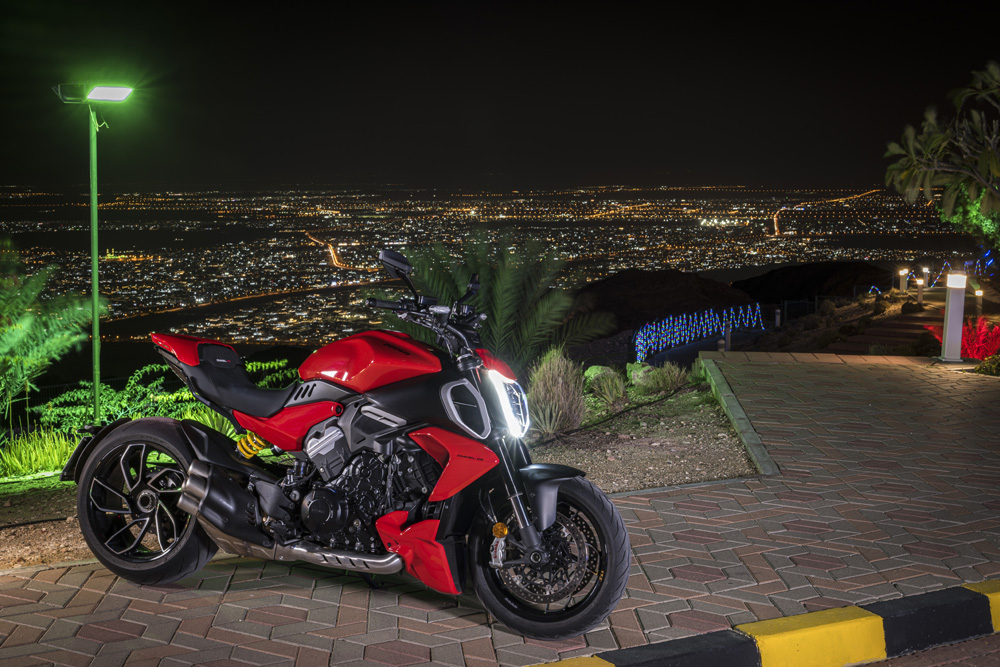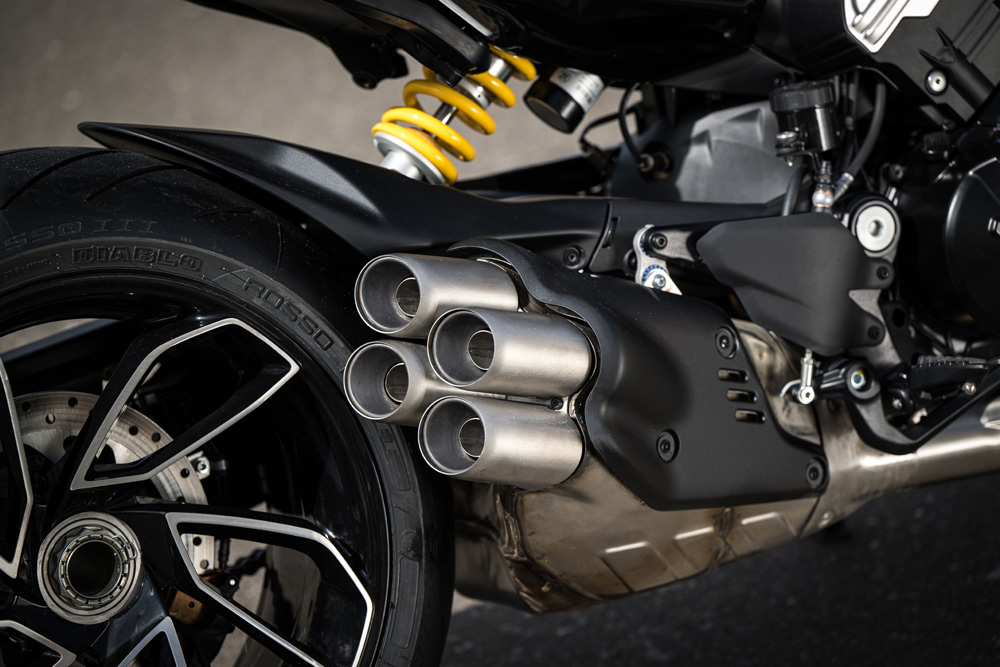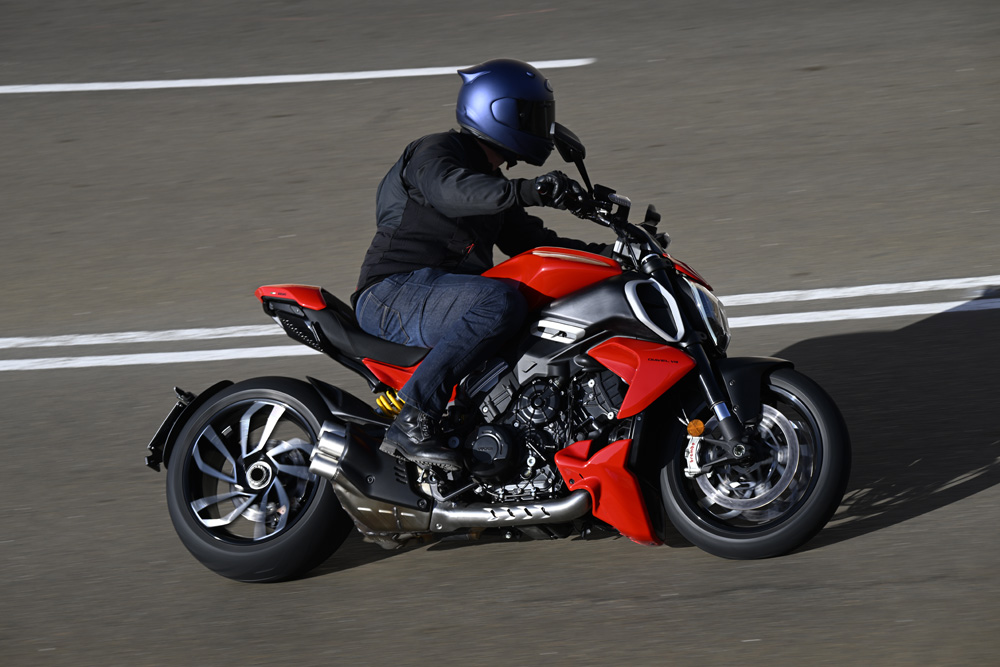Rennie Scaysbrook | February 16, 2023
In the world of power cruisers, none can hold a candle to the Ducati Diavel. Ever since the demise of the Yamaha VMax, the Ducati has been alone as the sportiest cruiser you can buy, although to call it a “cruiser” is about as loose a term as I can think of these days.
 The new Diavel V4—beastly, muscly, and over the top. Just how Ducati likes it.
The new Diavel V4—beastly, muscly, and over the top. Just how Ducati likes it.
By Rennie Scaysbrook
The Diavel was never really a cruiser. It could more accurately be called a comfortable naked bike—and in true Ducati style, it was much more about sport riding than cruising.
For the past 11 years, the Diavel has been powered by the motor the company was famous for—the L-twin. Originally in 1198cc, the model range expanded in 2016 with the arrival of the 1260 DVT (Desmodromic Variable Timing) engine in the rather extravagant XDiavel, with that motor finally making it into the base Diavel for the 2020 model year.
Fast forward to the present day, and the base model gets the updates first. The 2023 Ducati Diavel has thus been graced with the V4 Grantourismo motor that draws its heritage from the Multistrada V4 S, a motorcycle so good I named it my bike of the year in 2021, so it’s got good genes.
 You could be forgiven for thinking you were on a Streetfighter V4 S by the way the Diavel V4 rails in corners.
You could be forgiven for thinking you were on a Streetfighter V4 S by the way the Diavel V4 rails in corners.
The new V4 motor ensures the Diavel V4 can lay claim to a stomping 168 horsepower delivered at 10,750 rpm, while torque is rated at 93 lb-ft at 7500 rpm. That first number represents a seven percent increase in overall horsepower, and although torque has dropped two pounds per foot, how it is delivered is vastly improved over the 1260cc V-twin.
“For such high horsepower requirements, the only solution was to fit the V4 engine,” says the Diavel V4’s Product Manager Stefano Tarabusi. “The way in which the V4 engine makes the power is more progressive than the Testastretta V-twin, but you can reach the higher numbers much easier with the V4. We have learned a lot with the development of this engine in the Multistrada V4 range, which of course we started with the first Panigale V4. We look at this V4 engine as a 360° engine: you have smooth torque in the lower rev range, which translates in a strong midrange but at the higher end of the revs it continues to make power with no limits, much like a sportbike. This is very unique in this category.”
 LED lights up front are flanked by massive intakes in the traditional Diavel style.
LED lights up front are flanked by massive intakes in the traditional Diavel style.
The 1158cc V4 sitting inside the aluminum monocoque chassis is not identical to the Multistrada’s. Different camshafts and timing mated to a shorter first gear give the Diavel a more abrupt punch from a closed throttle at low rpm.
Also different is the intake and airbox, and of course, that spectacular exhaust with its Gatling gun-like four-barrel muffler. (Ducati also makes a wild sports exhaust for the Diavel V4 they call the “Spitfire” in honor of the British fighter plane, which shaves 24 pounds off and boosts power to a claimed 180 horsepower.) Ducati is also justifiably proud of the service intervals on the V4, with a major service on the valves now scheduled for 37,000 miles, so you could literally ride around the world one and a half times before you need to get the valves done. Oil changes are scheduled for 9000 miles.
 One of the main features of the Diavel V4 is the fantastic-looking exhaust with its four muffler outlets.
One of the main features of the Diavel V4 is the fantastic-looking exhaust with its four muffler outlets.
The motor may be all-new, but the bones of the Diavel are similar to previous generations. Ducati’s designers were mindful of preserving the shape and structure of the Diavel, which aims at “over-the-top design” with emphasis on the crouching stance of a runner on the starting line waiting for the gun.
Much of the work has been centered around weight and dimension reduction, with Ducati claiming a 29-pound reduction in overall mass compared to the outgoing 1260. The largest of this comes from the motor, with a claimed 11 pounds removed. A further 10.4 pounds have come off the monocoque frame, 5.3 pounds from the subframe, 2.0 pounds from the wheels, and 1.3 pounds from the front brake discs. All told, Ducati is claiming a 520-pound curb weight with a 5.3-gallon tank of gas.
 Webbed LED rear lights look magnificent.
Webbed LED rear lights look magnificent.
For the rider, the seat height has been increased 20mm to 790mm (31.1 inches), and the handlebar, which is now a two-piece unit and not a single handlebar as you’d expect, has been moved 20mm closer.
One of the few items to be carried over from the 1260 was the Marzocchi suspension and, of course, that model-defining 240-section rear wheel wrapped in a specially developed Pirelli Diablo Rosso III tire.
Consisting of 50mm forks and a monoshock, these are still conventionally adjustable, with Tarabusi telling me the weight cost at this stage of an extra four to six pounds to fit all the elements required for electronic suspension—forks, shock, control units, etc.—were just not worth it at this time. He didn’t rule out the possibility of a Diavel V4 S in the future that comes with shiny electronic Ӧhlins, but for now, fully adjustable conventional Marzocchis is what you get.
 The Diavel V4 offers the most comfortable ride position of any bike that could be considered a “power cruiser.”
The Diavel V4 offers the most comfortable ride position of any bike that could be considered a “power cruiser.”
Brembo has, once again, been left in charge of the brakes (as they are on all Ducatis), and the Italians have turfed the aging M4.32 monobloc calipers for the Stylema units first seen on the Panigale V4 S five years ago and mated to Cornering ABS.
Speaking of electronics, you get the usual plethora at your disposal in four riding modes of Sport, Touring, Urban and Wet mode, and two power modes that include the full 168 horsepower and a 115-horsepower level accompanied by a softer throttle response.
Inside the five-inch TFT display sits the adjustment for the four-stage traction control and wheelie control, three-stage cornering ABS and power launcher, Ducati’s up-and-down quickshifter, and cruise control, but no heated grips—those you must buy for $397 out of the Ducati accessories catalog, the same goes for tire-pressure sensors, which will set you back $452 (plus labor to fit them). And, sadly, the turn-by-turn navigation, which at just $80 on a $27K motorcycle, feels like penny-pinching to me.
 The Grantourismo V4, first seen on the Multistrada, is present in the Diavel V4 with revised intake, airbox, exhaust, cams and cam timing.
The Grantourismo V4, first seen on the Multistrada, is present in the Diavel V4 with revised intake, airbox, exhaust, cams and cam timing.
We were lucky enough to experience the new Ducati Diavel V4 in Abu Dhabi on what can only be described as the Pikes Peak of the Emirates, Jabel Hafeet. This is the only mountain in the Emirate of Abu Dhabi, with its elevation of 4098 feet, a little under a third of our Pikes Peak, but with its 6.64 miles rammed into 60 corners containing everything from dead stop to dead fast and everything in between. I know, six miles is not a long distance point-to-point, so that’s why we went up and down about 10 times, like kids on the latest rollercoaster. Oh, and the police had kindly shut the road down for us, so no speed limits or oncoming traffic.
As such, this was the perfect place to explore the outer limits of those claimed 168 horses hiding under the gas tank. It’d been the best part of seven years since I rode a Diavel, but I always got on with the model given the sportiness that the chassis exuded. Now in V4 guise, that love was ratcheted up a few notches.
 Five-inch TFT is plenty big enough but doesn’t take away from the minimalist style of the machine.
Five-inch TFT is plenty big enough but doesn’t take away from the minimalist style of the machine.
This level of power in a motorcycle that looks like this is a dichotomy of the senses. You don’t expect it to go anywhere near as fast as it does, but you do expect its low-speed manners to be impeccable. After all, this is a cruiser, right?
Err, not really.
Focusing on the sportier side of life, the Diavel V4’s motor absolutely shreds anything I can think of that can be considered a class competitor. With such velvety force on tap, the V4 can pull almost any trick in the book, from sportbike-style thrashing to simple, low-gear cruising. (I did a few runs exploring that, I promise.)
But it’s the midrange rev performance I found the most impressive. Third- and fourth-gear rides between 5000-8000 rpm offered such a broad range of performance I hardly needed fifth gear unless I was really sending it in an attempt to hang with Ducati’s renowned test and development rider, Alessandro Valia. Should you wish to carry out your Pecco Bagnaia fantasies, the Diavel V4 will oblige but only until the point where the chassis reminds you that, yes, it really is a cruiser—albeit a very sporty one.
There’s still a huge 240-section rear tire and a chassis that boasts a 26° rake and 62.7-inch wheelbase you have to deal with on the Diavel V4. Ground clearance is limited, and I often found myself scraping the hero knobs on the footpegs, but that is par for the course on a bike such as this.
 Foldable passenger pegs have always been a Diavel feature.
Foldable passenger pegs have always been a Diavel feature.
What isn’t is how the Diavel will just as happily carve tight corner arches as it will the cruiser-ubiquitous long, sweeping turns. This is quite the trick Ducati pulled in the Diavel chassis’ versatility, although the standard suspension settings are certainly on the soft side, so if you want more stability, especially under acceleration and especially under braking during sporty riding, you’ll want to twist the preload knobs at both ends.
I have long held the belief that manufacturers of cruisers have a secret deal with my chiropractor to make seats that ruin my lower back, my chiro, giving each manufacturer a little kickback after each visit. Thankfully, the Diavel seat is far more comfortable than most in this or even the more touring category. The mid-mounted controls, closer handlebar, and slightly raised seat at 31.1 inches are perfectly suited to my 6’1″ frame, with the shorter riders on this test also accompanying their ride with superlatives on the Diavel V4’s comfort, regardless of the type of riding they were doing.
 Night riding in Abu Dhabi hits a little differently.
Night riding in Abu Dhabi hits a little differently.
Although a relatively quick test, my time on the Diavel V4 revealed a bike that can do just about any tarmac-focused trick in the book short of scraping elbows at apexes. This has always been one of the Diavel’s strong points in that it can be many things to many riders, but with the advent of the V4 motor, the dial has been shifted firmly towards the riders who are perhaps coming off a sportbike and interested in taking things a bit slower, if only just. CN

2023 Ducati Diavel V4 Specifications
| MSRP: |
$26,689 Red, $26,995 Black |
| Engine: |
V4 Granturismo, 90° V4, counter-rotating crankshaft, Twin Pulse firing order |
| Valvetrain: |
Desmodromic Variable Timing, 4 valves per cylinder, |
| Cooling System: |
Liquid-cooled |
| Displacement: |
1158cc |
| Bore x stroke: |
83 x 53.5mm |
| Fuel injection: |
Electronic fuel injection system, 46mm elliptical throttle bodies, ride-by-wire throttle |
| Compression ratio: |
14.0:1 |
| Exhaust: |
4-2-1 |
| Transmission: |
6-speed |
| Clutch: |
Hydraulically controlled slipper and self-servo wet multiplate clutch |
| Electronics: |
Four Riding Modes, two Power Modes, Cornering ABS, Traction Control, Quickshifter, Wheelie Control, Cruise Control, Power Launch, full LED lighting, Daytime Running Light, backlit handlebar switches, 5” TFT color display, Ducati Multimedia System |
| Chassis: |
Aluminum monocoque frame |
| Front suspension: |
50mm Marzocchi fork, fully adjustable |
| Rear suspension: |
Marzocchi monoshock, fully-adjustable |
| Front brake: |
Dual 330mm semi-floating discs, radially mounted Brembo Stylema monobloc four-piston calipers, radial master-cylinder PR16/19, Cornering ABS |
| Rear brake: |
265mm disc, Brembo 2-piston floating caliper, Cornering ABS |
| Front tire: |
Pirelli Diablo Rosso III, 120/70 ZR17 in. |
| Rear tire: |
Pirelli Diablo Rosso III, 240/45 ZR17 in. |
| Rake: |
26° |
| Trail: |
4.4 in. |
| Wheelbase: |
62.7 in. |
| Seat height: |
31.1 in. |
| Fuel capacity: |
5.3 gal. |
| Weight (curb, claimed): |
520 lbs. |
VIDEO | Cycle News 2023 Ducati Diavel V4 Review
Cycle News 2023 Ducati Diavel V4 Review
